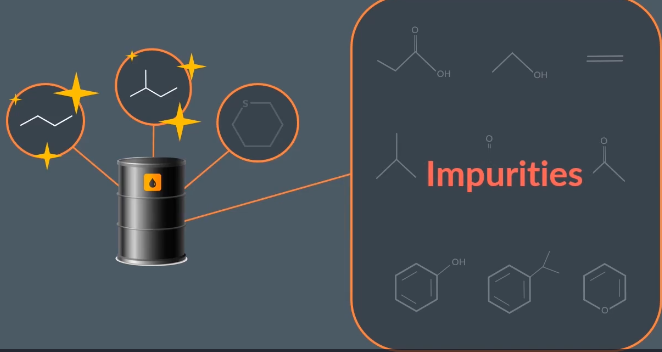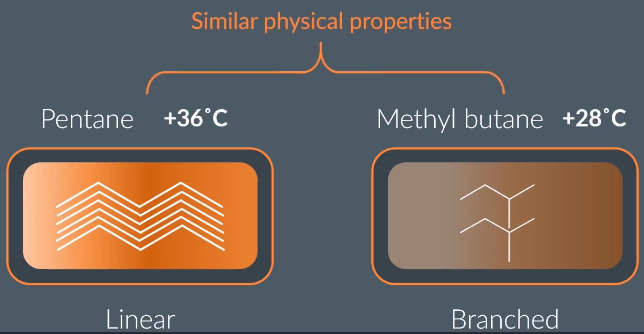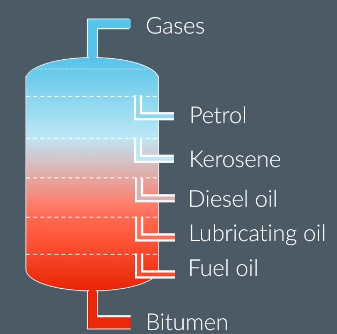Fractional Distillation of Crude Oil
1/8
There's no tags or description
Looks like no tags are added yet.
Name | Mastery | Learn | Test | Matching | Spaced |
|---|
No study sessions yet.
9 Terms

Why is it called Crude oil
becasue the oil is straight out of ground and hasnt had impurities removed yet eg) sulphur containing compounds
what is crude oil mostly made of
saturated alkanes
branched alkanes
sulphur containing compounds
In a homologous series, there is a ………… in physical properties across the series.
gradual change
We separate alkanes in crude oil into batches called…..
Each of these batches contains alkanes with similar…
fractions
physical properties/ molecular weights, boiling point
The fuels each fractions/alkanes are used for have very similar physical properties
each fractions have different uses eg) lorry fuel, candle oil as they are a range of alkanes with similar molecular weight
In a homologous series, as the molecules increase in size, the number of Van der Waals forces…
Meaning that, across a homologous series, the boiling point…
increases
increases
all alkanes are hydrocarbons + same molec formula ∴ are homologous do the more C they have the more H they have ∴ higher boiling point gradually as they get bigger across the homologous group
∴ as its hotter at the botom, larger alkanes condense at the bottom, lighter travel upwards and condense at the top
In industry, fractional distillation is a process to separate alkanes in crude oil. How?
1) Crude oil passes into a furnace ∴ pre heated where crude oil turns into a vapour from a previous liquid state
2)the crude oil passes into the bottom of the collumn where as you go up the temperature decreases (cooler at the top than the bottom→ NEG temp grad)
3)As the vapour rises up the collumn it cools
4) gasses rise and condense at their boiling points
5) Alkanes are spearated when collected into ‘fractions’ where larger alkanes condense first (lower down) at higher boiling points
Outline how compounds are separated using fractional distillation.
During fractional distillation, compounds such as crude oil are first heated in a furnace to make a vapour.
Next, this vapour passes into an extremely hot column, and as it rises up the column, it cools. Another way of saying this is that the column has a negative temperature gradient.
The fractions then separate by their boiling point, which means they condense at their boiling point and flow out of the column into separate fractions.
Because boiling points depend on molecular weight, larger molecules condense at higher temperatures, so are collected near the bottom of the column. Whereas smaller molecules condense at lower temperatures, so are collected near the top of the column.
Compared to linear alkanes with the same molecular formula, branched alkanes have…
fewer van der walls as they cant pack as tightly than liner
lower boiling points due to less forces acting
but as these boiiling points as so smilar, tehy condense off in the smae fraction as→ properties barely change→ same uses still
branched an linear alkanes with the same molecular formula (C5H12) have the slightly different boiling points but same uses as small differences fdont change the uses hence they separate at the same fraction


each fractio nas different uses….
Fraction 1) >70 carbons: Bitumen: solid at room temperature, very unreactive
Uses: lay road , roofing ‘thick black tar’
Fraction 2) 35-70 carbons: Fuel oil :
Uses : fuel in ships
Fraction 3) 19-35 carbons: Lubricants : solids or really viscous liquids
Uses: candles, lubricating engines
Fraction 4) 15-18 carbons: Diesel oil
Uses: fuel for cars and large vehicles
Fraction 5) 12-15 carbons: Kerosene/Paraffin: more volatile fuels in cf diesel→ needs lighting easily
Uses: Jet fuel, lighting
Fraction 6) 4-12 carbons: Petrol/Gasoline
Uses; fuel for smaller cars
Fraction 7) 1-4 carbons: Gasses: fuel that is gas at room temperature
Uses: fuel in gas form